I’ve been remiss in posting though I have not been slacking – just collecting a bevy of research to share on 1. changes in art consumption, 2. creating art for longevity and art against passivity, and 3. why drawing is a necessary tool for thinking and how the lack of drawing instruction is correlated to the rash of irrational thinking in our society now (even MFA art students do not need to know how to draw to graduate!!). Meanwhile a short and sweet list of 10 exhibitions I’ve culled that I think would be worth a pilgrimage. All text in italics are from the museum’s or gallery’s words. Have a happy week!! xox
-
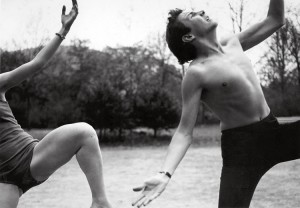
Hazel Larsen Archer, Elizabeth Schmitt Jennerjahn and Robert Rauschenberg, c. 1952, gelatin silver print, 6 1/4 x 9 ¼ inches. Estate of Hazel Larsen Archer and Black Mountain College Museum and Arts Center.
Leap Before You Look: Black Mountain College 1933–1957
ICA, Boston October – January, travels to the Hammer Museum in LA in the Spring
A small, experimental liberal arts college founded in 1933, Black Mountain College (BMC) has exerted enormous influence on the postwar cultural life of the United States. Influenced by the utopian ideals of the progressive education movement, it placed the arts at the center of liberal arts education and believed that in doing so it could better educate citizens for participation in a democratic society. It was a dynamic crossroads for refugees from Europe and an emerging generation of American artists. Profoundly interdisciplinary, it offered equal attention to painting, weaving, sculpture, pottery, poetry, music, and dance.The teachers and students at BMC came to North Carolina’s Blue Ridge Mountains from around the United States and the world. Some stayed for years, others mere weeks. Their education was unlike anything else in the United States. They experimented with new ways of teaching and learning; they encouraged discussion and free inquiry; they felt that form in art had meaning; they were committed to the rigor of the studio and the laboratory; they practiced living and working together as a community; they shared the ideas and values of different cultures; they had faith in learning through experience and doing; they trusted in the new while remaining committed to ideas from the past; and they valued the idiosyncratic nature of the individual. But most of all, they believed in art, in its ability to expand one’s internal horizons, and in art as a way of living and being in the world. This utopian experiment came to an end in 1957, but not before it created the conditions for some of the 20th century’s most fertile ideas and most influential individual artists to emerge.Leap Before You Look: Black Mountain College 1933–1957 focuses on how, despite its brief existence, BMC became a seminal meeting place for many of the artists, musicians, poets, and thinkers who would become the principal practitioners in their fields of the postwar period.
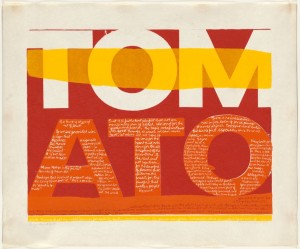
Corita Kent and the Language of Pop
Harvard Art Museums, September 3, 2015–May 8, 2016American artist Corita Kent juxtaposed spiritual, pop cultural, literary, and political writings alongside symbols of consumer culture and modern life in order to create bold images and prints during the 1960s. Also known as Sister Mary Corita, Kent is often seen as a curiosity or an anomaly in the pop art movement. Corita Kent and the Language of Pop positions Kent and her work within the pop art idiom, showing how she is an innovative contemporary of Andy Warhol, Edward Ruscha, Roy Lichtenstein, Jim Dine, Robert Indiana, and other pop art icons. The exhibition examines Kent’s screenprints as well as her 1971 bold “rainbow swash” design for the Boston Gas (now National Grid) tank located alongside I-93 south of downtown Boston, claiming it as the city’s own pop art monument. More than 60 of Kent’s prints appear alongside about the same number of works by her prominent contemporaries, along with a selection of films, books, and other works.The exhibition also expands the current scholarship on Kent’s art, elevating the role of her artwork by identifying its place in the artistic and cultural movements of her time. In particular, the exhibition explores how Kent’s work both responded to and advanced the concerns of Vatican II, a movement to modernize the Catholic Church and make it more relevant to contemporary society. The church advocated, among other changes to traditional liturgy, conducting the Mass in English. Kent, like her pop art contemporaries, simultaneously turned to vernacular texts for inclusion in her prints, drawing from such colloquial sources as product slogans, street signs, and Beatles lyrics.Kent (1918–1986) was a Roman Catholic nun, artist, and teacher. From 1936 to 1968 she lived, studied, and taught at the Immaculate Heart of Mary in Los Angeles, and she headed the art department at the college there from 1964 to 1968. In 1968, Kent left Immaculate Heart and relocated to Boston, where she lived until her death in 1986.I love Corita Kent and have written about her here.-
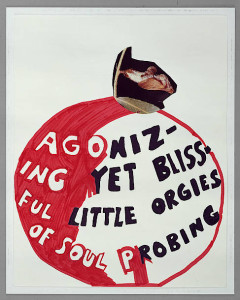
Frances Stark
Agonizing yet Blissful
2001. Ink and collage on paper. 14 x 11 in. (35.6 x 27.9 cm). Image courtesy of Galerie Buchholz, Cologne & Berlin.Uh-oh Francis Stark
Hammer Museum | October 11 – January 24, 2016
UH-OH: Frances Stark 1991-2015 will be the most comprehensive midcareer survey of the work of the Los Angeles–based artist and writer to date, featuring 125 drawings, collages, paintings, and video installations. Frances Stark (b. 1967 Newport Beach, CA), a key figure in the Los Angeles art community, has shown her work widely throughout the United States and Europe and is in frequent dialogue with many of her peers in the U.K. and Germany. For more than two decades she has been making poetic and poignant compositions combining text and imagery, exploring a wide variety of subjects, including writing, procrastination, the banality of life, failure, success, pride, self-doubt, motherhood, pedagogy, institutional critique, class, music, literature, poetry, philosophy, art, sadness, and relationships. The exhibition will track her 25-year career from early carbon drawings to intricate collages and mixed-media paintings to the more recent work, which includes PowerPoint slide shows, video, performance, and Instagram photographs. Words and images are at the heart of her practice, and like a lyricist, Stark employs both to create provocative and self-reflexive works that pose universal questions. -
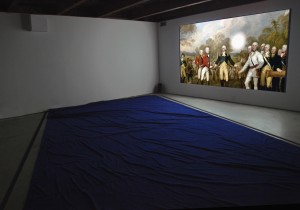
Rachel Rose
Palisades in Palisades
2014
Installation view: Chance Motives, SculptureCenter, New York, 2014.Rachel Rose: Everything and More
Whitney Museum | October 30, 2015 – February 7, 2016
An emerging artist based in New York, Rachel Rose will receive her first solo exhibition in the United States this fall in the Museum’s fifth-floor Kaufman Gallery. Rose (b. 1986) is known for her striking video installations that deftly merge moving images and sound with nuanced environments. She investigates specific sites and ideas by connecting them to broader, related subject matter. Rose’s presentation at the Whitney will physically engage with the architecture of the Museum’s new Renzo Piano–designed building. Using her own footage and found material, Rose addresses the ubiquity of images and how it generates meaning in contemporary society. - Native Fashion Now
Peabody Essex Museum, November 21, 2015 – March 6, 2016
From vibrant street clothing to exquisite haute couture, this exhibition celebrates the visual range, creative expression and political nuance of Native American fashion. Nearly 100 works spanning the last 50 years explore the vitality of Native fashion designers and artists from pioneering Native style-makers to today’s maverick designers making their mark in today’s world of fashion. Also examined is how non-Native designers adopt and translate traditional Native American design motifs in their own work, including Isaac Mizrahi’s now iconic Totem Pole Dress.Featuring contemporary garments, accessories and footwear spanning a variety of genres and materials, these designers traverse cross-cultural boundaries between creative expressions and cultural borrowing. From one of Patricia Michaels’ (Taos Pueblo) recent finale ensembles from the reality television series Project Runway to Jamie Okuma’s (Luiseño/Shoshone-Bannock) dramatically beaded Christian Louboutin boots and innovative works made from mylar, vinyl and stainless steel, Native Fashion Now underscores Native concepts of dress and beauty, which are inextricably bound to identity and tradition in a rapidly changing world. -
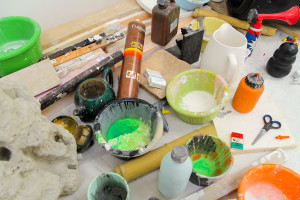
Peter Fischli/David Weiss, Untitled, 1994–2013 (detail). Hand-carved polyurethane and paint, dimensions variable. Solomon R. Guggenheim Museum, New York, Photo: Jason Klimatsis ©Peter Fischli David Weiss, Courtesy Matthew Marks Gallery
Peter Fischli David Weiss: How to Work Better
Guggenheim, February 5–April 20, 2016
For more than three decades, Peter Fischli (b. 1952) and David Weiss (1946–2012) collaborated to create a unique oeuvre that brilliantly exploits humor, banality, and a keen rethinking of the readymade to realign our view of the world. Peter Fischli David Weiss: How to Work Better will offer the most thorough investigation of their joint production to date, revealing the ways they juxtaposed the spectacular and the ordinary in order to celebrate the sheer triviality of everyday life, while creating an open-ended interrogation of temporality, visual culture, and the nature of existence itself. The retrospective will demonstrate the intricate interrelationships among Fischli and Weiss’s seemingly discrete works in sculpture, photography, installation, and video, each of which they used to confront, examine, and lampoon the seriousness of high art. In particular it will establish a sustained dialogue between Fischli and Weiss’s work with the moving image and their sculptural practice, with signature works like Suddenly This Overview (1981–2012), the hundreds of unfired clay sculptures that pillory established truths and myths alike, and The Way Things Go (1987), the inane filmic study of causational activity, appearing as leitmotifs throughout the space. The exhibition will further consider Fischli and Weiss’s extended meditations on the banality of existence, with virtually every body of work within the oeuvre represented by key objects from series including The Sausage Photographs (1979), Questions (1981–2002), Polyurethane Objects (1982–2013), Fever (1983), Grey Sculptures (1983–86), Equilibres (Quiet Afternoon) (1984–87), Visible World (1986–2001/2014), Rubber Sculptures (1986–2005), Airports (1987–2006), and Fotografías (2005), among others. -
22 Women – A Project by Alfredo Jarr
Sørlandets Kunstmuseum, NORWAY | October 10, 2014 – February 15, 2015
Twenty-two minuscule portraits of women are illuminated by a multitude of light projectors. The women are all brave activists who, despite being active in the world today, remain generally unknown to the wider public. Who are they, and why does Alfredo Jaar, at the same time as spotlighting them, acknowledge their invisibility? The stories about these women are told in a separate booklet accompanying the exhibition. -
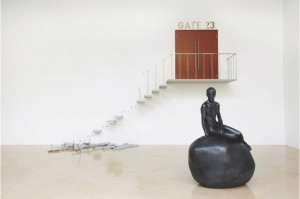
Elmgreen & Dragset View of the exhibition Aéroport Mille Plateaux at PLATEAU, Samsung Museum of Art Seoul (Korea), 2015, courtesy Galerie Perrotin
Elmgreen & Dragset – Seoul Korea
Samsung Museum of Art Seoul, KOREA
The Danish artist duo Elmgreen & Dragset transform the Samsung Museum of Art in Seoul into an airport, complete with check-in and duty free. It’s full of details, like a film setAn ultramodern and impersonal airport, like in the film parody Playtime by Jaques Tatie. Elmgreen & Dragset reimagine the essential elements of this space in PLATEAU, at the Samsung Museum of Art in Seoul. Inspired by the steel and glass building, which was designed by the South Korean firm Samoo, the artists use the metaphor of the airport to talk about contemporaneity, as the archetypal “non place”, a platform and a border between objects, spaces, people and ways of living, suspended between speed and waiting (the title of the exhibition, “Aéroport Mille Plateaux”, also refers to Mille Plateaux, the major work published in 1980 by the philosophers Gilles Deleuze and Félix Guattari). The spaces and functional details have been translated, replicated and mimicked throughout the museum, right down to the boarding pass that serves as your ticket to enter, various security systems, the waiting area, an ATM, the check-in counter and the duty free with lots of products for sale like whisky and perfume. 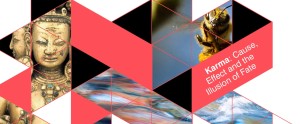
Karma Cause and Effect – talks at the Rubin Museum of Art | September 11 – December 30, 2015
The ancient concept of karma has been interpreted by many cultures around the world. In some, karma is synonymous with destiny. In Buddhism, karma is instead interpreted as a way of overcoming suffering in which we play a part; that our actions affect our conditions.This fall the Rubin hosts a conversation series that examines the repercussions of our actions, with a focus on mankind’s effect on the climate. Personalities from many walks of life will step on stage at the Rubin to share their views on global warming as well as other implications of karma and fate.-
Kindred Sprits
Dallas Contemporary |20 SEPTEMBER – 20 DECEMBER 2015
In a new series of paintings created for Dallas Contemporary, Adriana Varejão (b. 1964, Rio de Janeiro, Brazil), explores themes of colonialism and cultural identity. Using her own image as a starting point, Varejão changes her appearance through alterations in tone and facial markings. In doing so, she changes her ethic background and the manner in which her image is interpreted.
Tagged: Adriana Varejao, Alfredo Jaar, Black Mountain College, Corita Kent, David Weiss, Elmgreen and Dragset, Frances Stark, Hammer Art Museum, Harvard Art Museums, ICA, Peter Fischli, Rachel Rose, Whitney
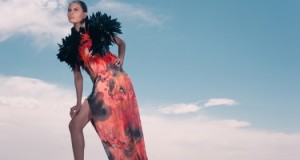
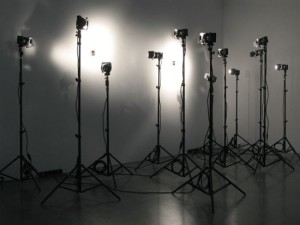
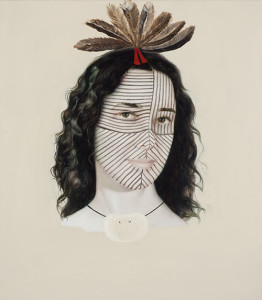
2 Comments
Diane Jacobs • September 28, 2015
Thank you Catherine, I very much enjoyed reading about these artists I had not heard of before. Hope you are well and we get together soon. best to you! diane
Catherine Haley Epstein • September 29, 2015
Thank you Diane!! Great to hear from you - I loved hearing about all you are up to lately too in your recent newsletter. Let's get together soon! I am going to Ireland shortly and will ping you when I get back!!
Would you like to share your thoughts?